3 June 2015
Stratification
Round Seven Review of the Final FIDE Grand Prix in Khanty-Mansiysk by GM Sergei Shipov.
The candidates for qualification into the Candidates Tournament follow different trajectories towards their goal, as is obvious now.
Caruana has been in no rush from the start of the tournament but then accelerated rapidly by winning three games in a row.
Karjakin’s trajectory resembled that of Caruana’s, but his winning streak was shorter by one win.
Tomashevsky started right off the bat, but then went into skidding and finally started losing.
Nakamura, on the other hand, was sitting on draws half the tournament and then at last managed to hit the mark. Luckily enough, the target that he knocked out was easier than easy itself. Thrashed by his opponents in previous battles, the French outsider failed to put up even a token resistance to the American.
Nakamura – Vachier-Lagrave
1.d4 Nf6 2.Bf4 b6 3.c4 Bb7 4.Nc3 e6 5.a3 d5 6.e3 Bd6 7.Bg5

7...h6
Because of this hasty move Black will need to demonstrate a very precise play in the upcoming game. Also unsuccessful is 7...Nbd7?! 8.cxd5 exd5 9.Nb5 with the idea of 9...Be7 10.Bf4! Rc8 11.Nxa7±.
However, the already tested move 7...Be7, and even more so 7...0–0! allows Black a reliable game without any problems.
8.Bxf6! Qxf6 9.cxd5 exd5 10.Qa4+!
This shot is quite unpleasant.
10...Kf8
Staying away from any complications. Of course, the position that could arise upon multiple exchanges of pieces was not easy to evaluate. One of the possible lines runs as follows: 10...Bc6!? 11.Bb5 Bxb5 12.Nxb5 c6 13.Nxd6+ Qxd6 14.Nf3 0–0 15.Rc1 c5 16.dxc5 bxc5 17.0–0 Nd7 18.Rfd1
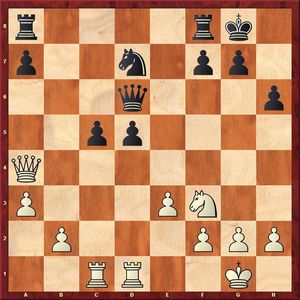
The commentators’ opinions about this position divided because I believed that Black was entitled to such kind of play as the hanging pawns are not that weak after all, whereas Rublevsky’s opinion differed from mine.
It looks like each commentator had its share of truth. White’s initiative is really substantial. His game is easier. Black, on the other hand, seems prone to falling an easy victim to all sorts of trouble. For example, 18...a5 19.Qc4! or 18...Nf6 19.b4! with an edge for White in both lines.
A precise solution can be found, nevertheless. For this purpose Black needs to switch to counterattacking, rather than go on defending: 18...Rfb8! 19.Qc4 (19.Qc2 a5!) 19...Nf6 20.Qxc5 Qxc5 21.Rxc5 Rxb2 22.Ra5 Ra2 23.h3 Rb8 24.Rxa7 Rbb2 25.Rf1 Ne4=.
11.g3!
A great future is in store for the light-squared bishop on g2.
11...c6 12.Bg2 g6
Perhaps queenside development should have been assigned immediate priority over additional king’s safety: 12...Qe7! 13.Nge2 Nd7 14.e4 dxe4 15.Nxe4.
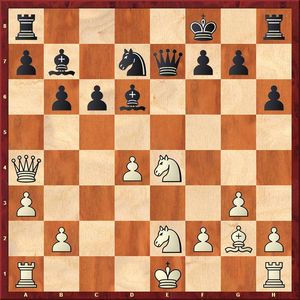
Here Black equalizes by walking over a very fine line: 15...c5 16.0–0 Bxe4 17.Bxe4 Rd8 (worse is 17...Qxe4 18.Qxd7 Qe6 19.Qxe6 fxe6 20.dxc5 Bxc5 21.Rad1 etc.) 18.Nc3 cxd4 19.Qxd4 Be5 20.Qb4 Bxc3 21.Qxc3!? (21.bxc3 Nc5) 21...Qxe4 22.Qc7 Qa8 (extremely dangerous is 22...Qe7? followed by 23.Rad1 and 24.Rfe1) 23.Rad1 g6 24.Rxd7 Rxd7 25.Qxd7 Kg7=.
In the light of the above-mentioned 15...h5! starts to look quite strong with the idea of providing room to the h8-rook to enter the game. From now on it’s all plain sailing: 16.h4 (16.0–0 h4 17.Rac1 Rh6!) 16...c5 17.0–0 Bxe4 18.Bxe4 Qxe4! 19.Qxd7 Rh6! maintaining the balance.
13.Nge2 Kg7 14.0–0
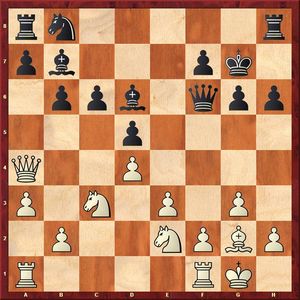
14...Qd8?!
During the game we believed that 14...Qe7! looked more credible. My intuition proved well founded: 15.e4 (or 15.b4 b5 16.Qb3 a5 17.e4 axb4 18.axb4 Rxa1 19.Rxa1 dxe4 20.Nxe4 Na6=) 15...dxe4 16.Nxe4 Nd7 17.Nxd6 (17.N2c3 Bc7 18.Rfe1 Rhe8!) 17...Qxd6 18.Rac1 Rhc8 19.Nf4 Nf6 with defendable position for Black.
15.e4! dxe4 16.Nxe4 Re8 17.Rad1!
White demonstrates strong and tenacious performance. 17.Nxd6 Qxd6 18.Nc3 Nd7 was good for equality only.
17...Na6
After 17...Bf8 White reacts with an elegant 18.Nf4! Nd7 19.d5 c5 20.Ne6+! fxe6 21.dxe6 Re7 22.exd7+-.
18.N2c3

Now you are up against a challenging task of defending against the d4-d5 advance. To put it mildly, not everyone is up to this job.
18...Nc7?
It turns out that Black was to open up the b-file as soon as possible bya 18...Rb8!! 19.d5 cxd5 20.Nxd5 Nc5 21.Nxc5 bxc5!! (worse is 21...Bxc5 22.Qxa7 Bxd5 23.Bxd5 Qe7 24.Qa4±) 22.Qxa7 Bxd5 23.Bxd5 Re7 24.Qa6 Rxb2 with an equal position already as 25.Bxf7? fails to 25…Rb6!–+.
19.Nc5!
Apparently Maxime either underestimated or failed to see this lunge at all.
19...bxc5 20.dxc5 Nd5 21.cxd6 Qxd6 22.Ne4 Qe5
From now on Hikaru has more than one way to win the game.
23.Rc1
Or 23.f4 Qe7 24.Qd4+ Kg8 (24...f6!?) 25.f5 with attack.
23...Nb6 (23...Re7!? 24.f4 Qc7 25.f5±) 24.Qb4! Rad8 (24...Rab8 25.f4!) 25.Nc5
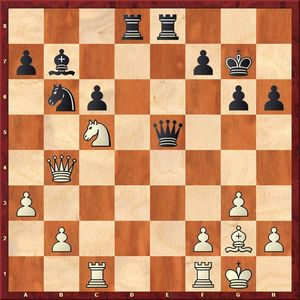
The end of the game happened surprisingly fast. The Frenchman did not relish the prospects of desperate struggling after 25...Ba8 and came up with
25...Rd4?? 26.Qc3 Bc8 27.Rce1!
This is the end of suffering as Black is about to lose his rook.
This is the fourth defeat in a row by Vachier-Lagrave. This is something unheard of for a player of his caliber. Now he is going to face all his future opponents playing for a win against him no matter the color, be it White, Black or even Green.
In this respect Evgeny Tomashevsky’s condition is only slightly better, or, in fact, a lot worse if we take into account his ambitions for qualification into the Candidates Tournament. He has lost his third game in a row and has practically spoiled all his chances to come second in the overall Grand Prix standings.
Giri – Tomashevsky

White’s central pressure has become quite tangible. Anish makes up his mind to broaden the front of attack just when his opponent finds himself in the time trouble.
38.g4!
This is a brilliant move of a talented player. However, had Evgeny had more time on his clock he would not have failed to come up with a rather unsophisticated rejoinder 38...fxg4! in order to meet 39.Qxg4 by 39...Rf8! 40.fxe5 Nxe5 with reasonable chances for the positive outcome of the game.
However, Black made a different move.
38...Qh4?! 39.gxf5 gxf5 40.Kh1!
Now both opponents are willing to take possession over the g-file.
40...Rd7 41.Rg1!
Formally speaking, 41.fxe5 was stronger; however, in this case White needed to anticipate the consequences of 41...Rg8.
The analysis, however, has proved the threats of Black to be ephemeral: 42.Rf3 Rdg7 and now, for example, 43.Bf4! Rg2 44.Qf1. White is going to follow up with Re1–e2 or with installing his knight on d6. Just try to go figure it all out when you feel exhausted and do not know which way to turn your head in an attempt to find your way through a myriad of possible continuations!
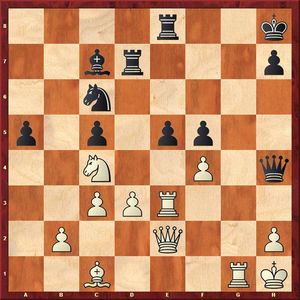
41...e4?
Black would retain good practical chances to maintain the fight after 41...Qf6! 42.Qg2 a4!, and White would need to demonstrate a lot of precision in the sequence of moves to follow: 43.fxe5! (43.Rg3 Qe6 44.fxe5 Nxe5 45.Re3 Qf7=) 43...Nxe5 44.Ree1! (rather than 44.Rge1? Rg8) 44...f4 45.Re4! f3 46.Qg5±.
42.Qg2 Qf6 43.Rg3
Unrepairable weakness of Black’s king renders his situation unbearable.
43...Qf7
Or 43...Qe6 44.dxe4 Qxe4 (44...fxe4 45.Rg7!) 45.Qxe4 fxe4 46.Rg5+-.
44.b3
The computer move 44.b4!! is quite delightful to the human eye.
44...Bd8
In the course of online broadcasting we subjected 44...Nd8 to analysis, but managed to find the rejoinder ourselves: 45.dxe4 fxe4 46.Ne5! Bxe5 47.fxe5 Ne6 48.Qxe4+-.
45.dxe4 fxe4
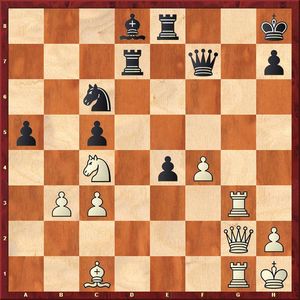
A simple-looking 46.Be3 required deep insight by calculating the consequences of a not so simple-looking piece sacrifice: 46...a4 47.bxa4! Qxc4 48.Rg7 Qe6 (48...Qd5 49.c4!) 49.f5! and White is winning.
Anish’s choice was more practical.
46.f5 Bc7
Now the line with 46...a4 is no longer that complicated: 47.Bf4 axb3 (47...Bf6 48.Nd6) 48.Ne5!
47.Rg4 Ne5 48.Rxe4 Rdd8 49.Bg5 Rb8 50.Qe2
Each move is now connected with some nice queen sacrifice ideas. For example, 50.Qg3! Nxc4 51.Qxc7!
50...Nd7 51.Re6! Rg8 52.Qf3 Rbe8 53.Qg4 Ref8 54.Nd6 Bxd6 55.Rxd6

55...Qxf5 56.Rxd7 (56.Bf6+ Qxf6 57.Rxf6 Nxf6 58.Qc4+-) 56...Qxg4 57.Rxg4 Rf5 (57...h6 58.Bxh6+-) 58.Rd5! Black resigns.
Thumbs up for Anish! Don’t give up, Evgeny...
Let us not jump to some hasty conclusions as the tournament is not over yet. However, it has become quite obvious that Evgeny lacks energy for the entire duration of the battle. He would demonstrate inventive ideas and creative play, but only for as long as the first three and a half hours of the encounter, when his batteries start draining away and the productiveness of his thinking and the level of his performance would come down rapidly as a result.
The leaders’ standings have not seen any major changes. Caruana could have increased the gap with his pursuers had it not been the game against the invincible rival of his.
Caruana – Gelfand
1.d4 Nf6 2.c4 g6 3.g3 c6 4.Nf3 Bg7 5.Bg2 d5 6.cxd5 cxd5 7.Nc3 0–0 8.Ne5
Breathing life into this symmetrical line that features an increased margin of safety for Black is an extremely challenging task. Well, Fabiano failed to rise to the occasion also.
8...Bf5 9.Be3
This novelty is now one more item on the list of other equally unsuccessful attempts to gain an advantage, together with 9.0–0, 9.Bf4, 9.Qb3 etc.
9...Qb6 10.Qd2
This setup is likely to explain the reason why White has made up his mind to delay castling. However, the effective output of this idea has proved relatively low.
10...Nc6!
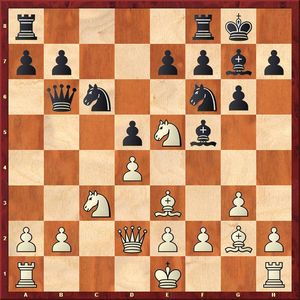
11.Rc1
The central pawn is poisoned. After 11.Nxd5? Nxd5 12.Bxd5 Rad8 White is in a bad shape in all lines. 13.Bxc6 is met by 13...Bxe5!
11...Rac8 12.0–0
Here 12.Nxd5 does not make sense in view of 12...Nxd5 13.Bxd5 Nxe5 14.dxe5 (14.Rxc8 Nd3+!) 14...Rxc1+ 15.Qxc1 Qa5+ 16.Qd2 Qxd2+ 17.Bxd2 Bxe5 and it is White that is struggling for equality.
12...Rfd8
Black is okay here, no doubt. He deployed his pieces to best squares and threatens with the knight jump to e4.
13.Na4 Qb5 14.b3 Nxe5 15.dxe5 Ne4 16.Qb2
In the case of 16.Bxe4 dxe4 17.Rxc8 Rxc8 18.Bxa7 Bxe5 the difference in strength between minor pieces outweighs the drawbacks of Black’s pawn structure.
16...b6 17.Bd4
White has come up with reasonable rearrangement of his forces and managed to stabilize his position in the center, but that does not influence the evaluation of the position.
17...Qb4
Black is increasing the pressure while White’s knight still remains in the exile on a4. A prophylactic move 17...h5 does not look bad either in order to do away with the ideas of the f2-f3 and g3-g4 stabs.
18.Rfd1
18.e3 would have been responded with 18...Nc5 19.Nxc5 bxc5 20.Qc3 Qxc3 21.Bxc3 c4 22.Bd4 f6 with the idea of 23.exf6 Bxf6 24.Bxa7?! Bb2! and Black’s passed pawn starts to look really menacing.
18...Rxc1 19.Rxc1 Rc8 20.e3
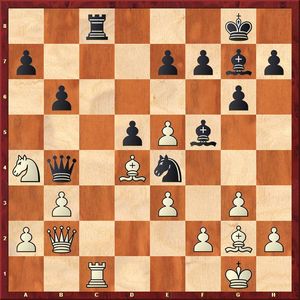
20...Nc5?!
Black shows some optimism or maybe simply bluffs! It is highly unlikely that Boris could have calculated all the ensuing lines, he just believed that everything was going to come out perfectly well for him.
Simpler is 20...Rxc1+ 21.Qxc1 h5, and all possible attempts to display activity by White are open to undesired consequences: 22.f3 Ng5 23.Nc3 (23.Bc3 Qb5 24.e4? Nh3+!) 23...Ne6! 24.Nxd5? Nxd4 25.Nxb4 Ne2+ etc.
21.e6
It appears that Caruana fell for it, believing that Black was OK.
He should have double checked, because after 21.Bxc5 bxc5 22.Bxd5 White would win a pawn and obtain practical winning chances. In order to create counterplay, Black would need to handle this position with a surgeon’s touch. After 22...Rd8 23.e4 Gelfand was unlikely to go for such “spicy” lines as 23...Bxe4! 24.a3! Bxe5! 25.Qxe5 Qd2 26.Qxe4 Qxc1+ 27.Kg2 e6! 28.Bxe6! etc. Calculating this far in every game is a sure way not to live as long as to celebrate your 50th anniversary.
Black would have retained a definite amount of compensation for the pawn in the form of his bishops pair via 23...Bg4 24.f4 g5!, for example, 25.a3! Qd4+ (25...Qa5?! 26.Nxc5 e6 27.b4 Qb6 28.Bc4±) 26.Qxd4 cxd4 27.Nc5 e6 28.Bc4 gxf4 (28...Bh6 29.f5!) 29.gxf4 Bh6 30.Rc2! Kh8 31.Rf2
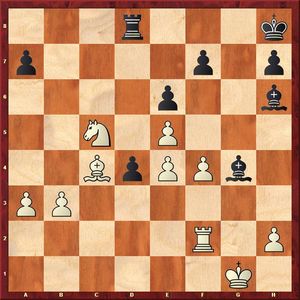
31...d3! 32.Nxd3 Rd4 with a drawish outcome not that far away.
21...Bxe6
Of course not 21...Bxd4? in view of 22.exd4+–.
22.Bxg7
22.Nxc5 Rxc5 23.Bxc5 Bxb2 24.Bxb4 Bxc1 25.Bxe7 Bb2= would have resulted in an equal position.
22...Nxa4 23.Rxc8+ Bxc8 24.Qa1
In the case of 24.bxa4 Qe1+ 25.Bf1 Ba6 26.Qa1 Qxf1+ 27.Qxf1 Bxf1 White would seek to bail out in an opposite-colored bishop ending being down a pawn.
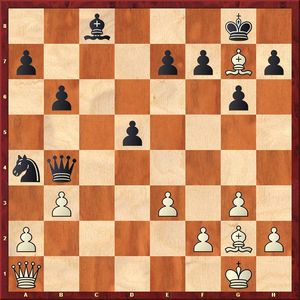
24...f6!
This is the most streamlined solution. In the case of 24...Nc5 25.Bxd5 Be6 26.Bc3 Qg4 27.Bg2! one can feel apprehensive of a pair of white bishops. However, Black’s counterplay is sufficient to provide him with a comfortable game after 27...Qe2!
25.Bxf6 exf6 26.Bxd5+
White would gain nothing by 26.Qxf6? Nc3 27.Qd8+ Qf8 with an edge for Black.
26...Kg7 27.bxa4 Qxa4
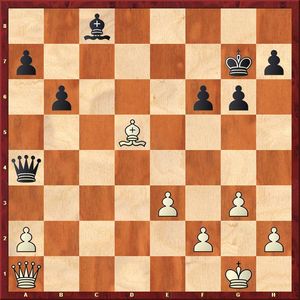
28.e4 Qb5 29.Kg2 Qc5 30.Qd1 Bd7 Draw.
This was Boris’s seventh draw in a row and it looks like there is more to come.
One of his main pursuers was very likely in the mood to score another point in the seventh round. However, his game saw too many unexpected surprises.
Karjakin – Jobava
1.e4 e6 2.d4 d5 3.Nc3 Nc6 4.e5 Nge7 5.Nf3 Bd7?!
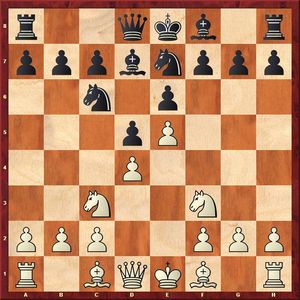
This cute little move surprised me a great deal. As Black is really short on space one may have an impression than he needs to break out as soon as possible. Instead, Black comes up with a very modest move, giving White a whole tempo to stabilize his position in the center.
The previous games saw Baadur resorting to 5...Nf5 (as in Hovhannisyan-Jobava, Al Ain 2013 and Saric-Jobava, Wijk aan Zee 2014), but Sergei must have prepared for this continuation very well.
So, the surprise effect must have been the guiding reason behind his opening preference.
6.Ne2
This is one of several perspective directions. White is relieving his guard on с3.
6...Nf5 7.Ng3
This is a novelty.
7.c3 has proved to be a reasonable move together with 7.g3!? with the idea of Bf1–h3. All my analysis lines feature advantage for White. Jobava, however, is likely to hold his own point of view on this matter...
7...Nh4!
It is important that White’s most important knight be exchanged.
8.c3 g6
Black’s plan has become more or less clear as he is going to deploy his bishop on g7 or h6 depending on the circumstances. When a suitable occasion presents itself he is going to carry out the f7-f6 lever.
A simple line 9.Nxh4 Qxh4 10.Bd3 suggested itself in order to neutralize the f7-f6 advance by f2-f4 and 0–0. Baadur admitted that 10...Bh6 was his intention in order to follow the exchange of bishops with castling long and taking it from there. Technically speaking, that position would also feature an insignificant but stable edge for White. A lot more interesting, of course, was a knight lunge 11.Nh5! Bxc1 12.Nf6+, when Black could not continue putting up with such thorn in the flesh and would have been forced to part ways with his queen: 12...Qxf6 13.exf6 Bxb2.
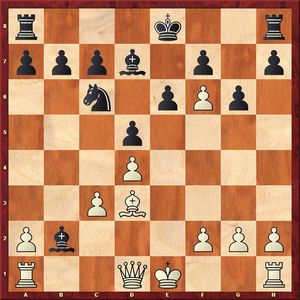
Well, Black has a definite amount of compensation and the resulting position is just to the liking of the Georgian inventor.
9.Bf4
This is a strong move both from the formal and from the analytical points of view. From the practical point of view, however, it has proved to be not such a success. Fortification of the e5-square has quite suddenly produced the reverse effect of its weakening!
9...f6!

Sergei failed to measure up to the complexity of the tactical solution that was available in this position.
10.Nxh4
This exchange allows Black to rapidly mobilize his forces. Weakening of Black’s kingside could have been capitalized on by 10.Nh5! In all subsequent lines Black is going to find himself passing through a lot of hardships. Bad is 10...gxh5? 11.Nxh4 and the queen cannot be prevented from landing on h5. On the other hand, 10...Nxf3+ 11.Qxf3 gxh5 12.Qxh5+ Ke7 13.exf6+ Kxf6 14.Bg5+ results in the loss of Black’s queen.
More probable continuation would be 10...fxe5 11.Nxe5 Bd6 12.Qg4 (I will keep the engine move 12.Ng7+ out of this analysis) 12...Nxe5 (12...0–0 13.Nxd7 Qxd7 14.Qxh4±; 12...Nf5 13.Bd3 Qe7 14.Ng3 Bxe5 15.dxe5 0–0–0 16.Bg5 Qc5 17.Qe2!±) 13.dxe5 Be7 14.Nf6+ Bxf6 15.exf6 Qxf6 16.Bxc7 e5 (16...0–0 17.f4!) 17.Qb4 Bc6 18.0–0–0, and White’s advantage has become indisputable.
10...fxe5 11.Nxg6 hxg6 12.dxe5 Qh4!
The defender of e5 needs to be defended himself.
13.Ne2
In the case of 13.Qd2 Bh6 (13...Be7 14.Ne2 0–0–0) 14.Bxh6 any recapture on h6 with the subsequent blow g6-g5 to challenge the potential f2-f4 advance could have secured reasonable counterplay for Black. This is, of course, easier said than proved by any specific continuations...
13...0–0–0
Another noteworthy alternative would be 13...Bg7 14.Qd3 (or 14.Bg3 Qh6 15.f4 g5=+) 14...0–0–0 15.Qxg6 Rdg8 16.Qg3 Qh7 17.Qe3 Qc2 18.Qd2 Qa4 with counterplay for Black.
14.Qd2
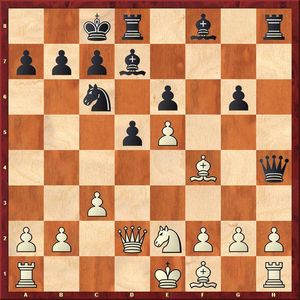
14...Rh5!?
An inventive mind needs room to stretch his imagination! The scheduled 14...Bh6 also promised reasonable prospects. However, it was necessary to see that in the case of 15.Bxh6 Rxh6 16.g3 Qe4 17.Qxh6 Qxh1 18.f4 Qe4 (the immediate advance 18...d4! 19.Qxg6 Ne7! leads to a wild game) 19.0–0–0 there is a breakthrough 19...d4! 20.Nxd4 Nxd4 21.Rxd4 Qe3+ 22.Kd1 Ba4+ 23.b3 Rxd4+ 24.cxd4 Qxd4+ 25.Ke1 Qe3+ 26.Kd1 Qd4+ with a perpetual check.
15.Ng3 Rxe5+ 16.Bxe5 Nxe5
Black has compensation for the exchanged sacrifice. Karjakin, however, comes up with an efficient rejoinder.
17.Qe3!
During online broadcasting Sergei and I endowed the move 17.Qd4?! with groundless praising because it would result in a position with better chances for Black: 17...Qxd4 18.cxd4 Bb4+ 19.Ke2 Nc6 20.Rd1 (20.Ke3 e5!) 20...Ba5! (20...e5 21.dxe5 Nxe5 22.f3 Bb5+ 23.Kf2 Bc5+ 24.Ke1 Bb4+ 25.Kf2= would end up in a draw only) 21.Ke3 Bb6 and White would fail to keep his hold of the d4-square: 22.Bb5 (or 22.f4 e5 23.fxe5 Nxe5 24.Be2 Re8 25.Kf4 Nc6 etc.) 22...Nxd4 23.Bxd7+ Kxd7 and e6-e5.
17...Nc6 18.Bb5 Bh6 19.Qe2 e5 20.Rd1 a6!

This move left us with the first impression of being a blunder. But it turns out to be an excellent attempt to embark on the counterplay.
21.Bxa6!
After 21.Bxc6 Bxc6 22.0–0 Bf4 23.Rfe1 Rh8 24.h3 Black should not rush with his attack: 24...Bd7? 25.Rxd5 Bxh3 26.gxh3 Bxg3 27.Qg4+!
The preparatory move 24...Kb8! is significantly stronger.
21...Ne7!
Both opponents quickly calculated the consequences of the line with 21...bxa6 22.Qxa6+ Kb8 23.Rxd5 Ne7 24.Ra5 Bc6 25.Ra3! Bd5 26.Ra4 and White is winning.
22.Bb5
In the case of 22.Bd3 e4? 23.Bxe4 dxe4 24.Qxe4 White would obtain a sizeable advantage. Baadur, however, intended to meet it by 22...Bf4!, increasing the pressure gradually. Further computer analysis brings forth the lines of such complexity that they could hardly be uncovered over the board: 23.h3 e4 (also good is 23...Qg5 24.h4 Qf6 25.Nf1 e4 26.Bc2 Rf8) 24.Bc2 e3 25.Rd4! g5 26.Nh5! exf2+ 27.Kf1! c5 28.Rd1 Bd6 29.Nf6 Bc6 30.c4! d4 31.Ne4 with a slight edge for White.
22...c6 23.Qxe5
23.Bd3 Bf4 24.h3 needs further analyzing.
23...Bf4
Perhaps even stronger is 23...cxb5!? 24.Rd4 Qg5 25.Qxg5 Bxg5 26.0–0 Bf6 etc.
24.Rd4?!
White would find himself in a better version of the endgame after 24.Qd4! cxb5 (24...Bxg3 25.fxg3 Qxd4 26.Rxd4 cxb5 27.0–0 Bf5 28.Rh4ѓ) 25.Ne2 Bg5 26.0–0 Qxd4 27.Nxd4 with a slight edge.
24...Bxe5 25.Rxh4 cxb5 26.0–0

The engine evaluates the resulting endgame as optimistic for White. As a human player I would rather prefer having minor pieces versus rook.
26...Kc7
This is hardly a good move. Black should have immediately embarked on increasing the scope for his bishops: 26...Nc6! 27.Re1 (27.a3 d4!) 27...b4 28.cxb4 Bxb2.
One is entitled to object, however, that the operating scope would open up for the white rooks in an equal measure. In general, this path was close to impossible to evaluate over the board.
27.Re1 Kd6 (27...Nc6!?) 28.Rh7 Nc6 29.Rd1 (29.Rh6 Rg8!) 29...Ke6
I was under the impression that White stood some winning chances in this position. Sergei just needed to come up with 30.Ne2! b4 31.f4! Bf6 32.f5+!
With the time trouble looming ahead he opted for a sure bird in hand.
30.Re1 Kd6 31.Rd1 Ke6 32.Re1 Draw.
There also took place a change in the honorary escort of the tournament leader. One Petersburger (the regular play of the Cuban for the team of St. Petersburg must be rewarded, in my opinion, with a Russian citizenship and an apartment on the Nevsky Prospect) relieved another Petersburger.
Dominguez – Svidler
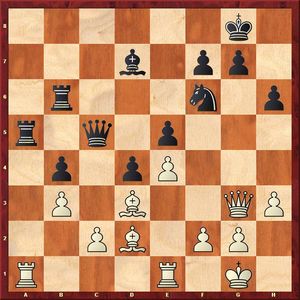
Up to a certain moment both opponents performed on equal terms, but now Peter gives in. If it were White to move in the position on the diagram, he could have struck with the 26.Bxh6! blow that was well justified by the following line: 28...Nh5 29.Qh4 Rxa1 (29...Rxh6 30.Qd8+!) 30.Rxa1 Rxh6 31.Qd8+ Kh7 32.Qxd7 +–.
Therefore, Black opted for 25...Nh5? 26.Qh4 Nf6. However, it allowed White to open up the center under better circumstances.
27.f4!
From now on his attack develops without a hitch:
27...Rxa1 28.Rxa1 Bc6 29.fxe5 Qxe5 30.Bf4 Qe8
Slightly more stubborn would be 30...Qe7, which is recommended to be met by 31.e5 Nd5 32.Qxe7 Nxe7 33.Bg3 with the idea of Bg3-f2.
31.e5!
While in time trouble it makes no sense calculating such complicated lines as 31.Bxh6 Bxe4!.
31...Nd5 32.Bg3 Bb5 33.Qxd4 Bxd3 34.cxd3 Qc6

35.Kh2! Rb5 (35...Rb7!?) 36.Ra7 h5 37.Qe4 Rc5 38.e6!
And Black resigned in view of 38...Qxe6 (38...fxe6 39.Qg6+-) 39.Ra8+ Rc8 40.Qxe6 fxe6 41.Rxc8+.
But let’s go back to the position on move 25 where it is Black to move and play some different idea: 25...Bc8!

Now the idea of 26.Bxh6? would work no longer in view of 26...Nh5 27.Qh4 Rxa1 28.Rxa1 Rxh6 29.Qd8+ Kh7, when the black bishop is no longer undefended.
What other features are there in the position to guide Black into finding this maneuver? Well, these are purely positional features. White’s activity in the center is best met by either Nf6-d7 to lend additional protection to the e5-square or by counterattacking the e4-pawn, in which case the black bishop is going to be useful on the big diagonal. Both requirements are best satisfied by Bd7-c8. For example, following 26.f4 Rxa1 (also good is 26...Nd7) 27.Rxa1 Bb7! White is obliged to switch to the defensive because after 28.fxe5 Nxe4! he can find himself in an inferior position already. But Svidler failed to get sight of this opportunity... It needs to be added that he usually plays faster than his opponents. The reverse side of this practical approach is that he sometimes passes over such subtle opportunities.
Following the completion of round seven the general picture has remained unchanged: Caruana is breaking away from the rest of the field, while other players do their best to catch up with him, but to no avail so far.
P.S. The game Jakovenko-Grischuk resulted in a premature draw and thus requires no commenting.




















